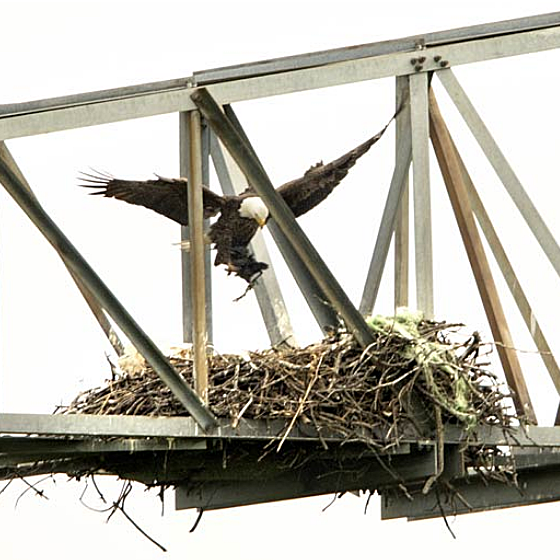Welcome to the John Bunker Sands Eagle Tower Cam
Nature cameras offer an unprecedented view of wildlife .. up close, and in high resolution color. Among eagle cameras around the world, the John Bunker Sands Wetland Center Eagle Tower Cam is exceptional, and unique.
Newcomers and experienced eagle watchers alike will enjoy reading about the John Bunker Sands Eagle Tower bald eagles, and the back-story about the nest and camera system.
Links to other bald eagle sites are provided under the "Information" link in the banner at the top of each page. To access the links, hover your cursor over "Information", then "Eagle Information Sites".
An extensive history of this nest as well as additional information links are available on the John Bunker Sands Wetland Center website.
Navigating This Site
Navigate this site through the menu bar at the top. Bold Blue Links in the menu bar at the top of each web page and within the text are to other locations or pages in this website. Bold Red Links in the menu bar and within the text will open a new tab in your browser and take you to a different website. To return here, just click the JBS Eagle Tower Cam tab in your browser. The "Photo Gallery" link in the menu bar has a drop-down box where you can select from two different events in the history of the JBS Eagle Tower Cam: 1) Moving the nest in 2014 from the original high-voltage tower to the new tower, or; 2) Installation of the new camera system in September 2020. Pages that exceed one screen in length have an eagle icon that appears in the lower right corner of the screen. Clicking the eagle will scroll back to the top of that page.
A link to the John Bunker Sands Wetland Center website as well as other informational bald eagle sites are included under "Helpful Links" located in the bottom of the column to the right of each page.
JBS Eagle Tower Cam Weather
Weather at the Eagle Tower Cam site (box in the column to the right) is derived from data provided by the National Oceanic and Atmospheric Administration ("NOAA"). The data does not refresh automatically. Updates can be easily obtained by clicking the "Update Weather" button directly below the weather box. An update will also occur any time you change from one page to another on this site.
The colored rectangle in the top of the weather box shows current sky conditions in a graphic image, temperature (in degrees F), and wind direction and speed (mph). A small dark rectangle in the bottom center of the colored rectangle shows predicted low and high temperature for this day. Three small boxes directly below show predicted weather for the next three days.
Wind speed from NOAA is measured at a height of 10 meters (33 feet) above the ground. The nest at the JBS site is approximately 85 feet high. Consequently, the displayed wind speed is slower than the wind at the nest. The approximate windspeed at the nest may be calculated by multiplying the displayed windspeed by 1.35.
Four tabs are present at the top of the weather box: "Weather", Wind , "Rain", and "Sun". By default, the "Weather" tab is displayed when you first access this site. Selecting the "Wind" tab will display more detail about the windspeed and direction than in the default box such as current wind speed, peak gust, and the directional trend for the day. "Rain" shows the predicted chances for rain for the next three days. "Sun" shows the relative sun angle for a given time of day, as well as sunrise and sunset times for today and tomorrow. While you're looking at the "Sun" tab, there's a vertical bar on the right side of the box. Clicking the bar opens another box that displays sunrise and sunset times, as well as morning and evening twilight times. Clicking the bar again closes the box.
Moving your cursor anywhere over the main weather box will cause a pop-up to appear with the area weather forecast for the day, as well as other data not visible in the main window.

